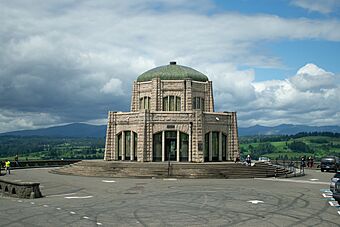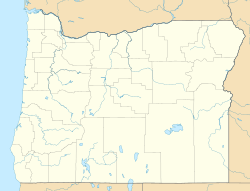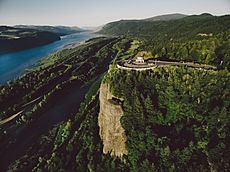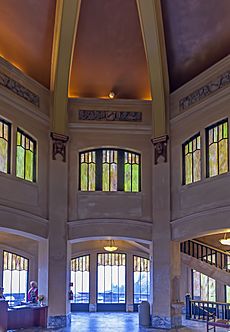Vocational Agriculture Building facts for kids
Quick facts for kids |
|
|
Vista House
|
|
|
U.S. Historic district
Contributing property |
|

Vista House
|
|
| Location | 40700 E Historic Columbia River Highway Corbett, Oregon |
|---|---|
| Area | 3 acres (1.2 ha) |
| Built | 1916–1918 |
| Architect | Edgar M. Lazarus |
| Architectural style | Art Nouveau Art Deco |
| NRHP reference No. | 74001705 |
| Added to NRHP | November 5, 1974 |
Vista House is a special building located at Crown Point in Multnomah County, Oregon. It serves as a museum and a tribute to the brave Oregon pioneers. It's also a handy rest stop for people traveling on the Historic Columbia River Highway.
This unique building sits on a rocky cliff, about 733 feet (223 m) above the Columbia River. It offers amazing views of the Columbia River Gorge. The Vista House is shaped like an octagon and is made of stone. It was designed by Edgar M. Lazarus in the Art Nouveau style and finished in 1918.
In the year 2000, a big project began to restore the building. This work took five years to complete. Vista House is near the town of Corbett and is listed on the National Register of Historic Places. It's also a popular spot to see the aurora borealis, also known as the Northern Lights!
Contents
History of Vista House
Building the Vista House
The Vista House was designed by Edgar M. Lazarus, a famous architect from Oregon. When it was being built, some people in Oregon joked about its high cost. They called it the "$100,000 Outhouse" because of its fancy marble inside and shiny brass parts.
The first money raised for the project was about $3,812. However, the building ended up costing much more. The building itself cost around $70,000. An extra $9,000 was spent on a rock wall nearby. Paving and grading cost $8,000, and the architect received $6,000. Other small costs added up to $3,000.
The idea for a viewing spot at this location came from Samuel Lancaster. He was an engineer working on the Columbia River Highway. Lancaster imagined a place where people could quietly enjoy the beautiful views of the Columbia River.
Construction of the Vista House started on December 29, 1916. It was completed in 1918 and officially opened on May 5, 1918. The opening ceremony was led by Frank Branch Riley from Portland.
Samuel Lancaster also suggested the name "Vista House." A group called the Vista House Association was formed to raise money. This group included 52 important business and community leaders from Portland. However, they couldn't raise enough money. Most of the building costs were paid by Multnomah County. John B. Yeon was in charge of supervising the construction.
How Vista House Was Designed
Lazarus's design for Vista House includes parts of the Jugendstil style. This was a German version of Art Nouveau, popular in Europe from the late 1800s to about 1910. The building is mainly a round room called a rotunda, about 44 feet (13 m) across.
It has an octagonal shape at its base, which is about 64 feet (20 m) wide. This lower part holds restrooms and a gift shop. The rotunda itself is 55 feet (17 m) tall. Stairs inside lead up to a viewing platform near the dome.
The outside of the building is made of gray sandstone, and the roof has green tiles. Inside, the building is beautifully decorated with marble, even in the restrooms. The inside of the dome is lined with bronze. The upper windows have colorful, simple glass designs. Similar colored glass is also found at the top of the main level windows.
Bringing Vista House Back to Life
Vista House is a very popular stop for tourists driving along the Historic Columbia River Highway. The building was carefully repaired and its inside was made to look like it did in 1916. It reopened in 2005 after five years of restoration work.
The roof was completely rebuilt with new tiles and a special waterproof layer underneath. The outside repairs were finished by 2002. Inside, workers fixed and replaced finishes. They also updated the sewer system and installed a geothermal heat pump system. This system uses the earth's temperature to help with heating and cooling.
The restoration also made Vista House easy for people with disabilities to visit. A special lift was added between the different levels. From the top of Vista House, which you can reach by stairs, you can see Portland and Vancouver, Washington to the west. To the east, you can see Beacon Rock on the Washington side of the gorge.
The Oregon Parks and Recreation Department owns Vista House. It was added to the National Register of Historic Places on November 5, 1974. Crown Point, where Vista House stands, was named a National Natural Landmark in 1971. Vista House is a very important part of the Columbia River Highway National Historic Landmark.
Gallery
-
A view of the Columbia River from the Vista House mezzanine
See also
External links
- Friends of Vista House
- Crown Point State Scenic Corridor at the Oregon Parks and Recreation Department
de:Vista House











